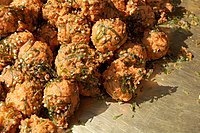Frying
This article needs additional citations for verification. (May 2015) |

Frying is the cooking of food in oil or another fat.[a][1] Similar to sautéing, pan-fried foods are generally turned over once or twice during cooking to make sure that the food is well-made, using tongs or a spatula, while sautéed foods are cooked by "tossing in the pan".[2] A large variety of foods may be fried.
History
This section needs expansion. You can help by adding to it. (December 2009) |
Frying is believed to have first appeared in the Ancient Egyptian kitchen, during the Old Kingdom, around 2500 BC.[3]
It is believed that frying was created, and used, as a way to preserve food. One of the earliest items to be fried were cakes known today as
Variations
Unlike water, fats can reach temperatures much higher than 100°C (212°F) before boiling. This paired with their heat absorption properties, neutral or desired taste, and non-toxicity, makes them uniquely valuable in cooking, especially frying. As a result, they are used in a wide variety of cuisines.
Through frying, one can sear or even carbonize the surface of foods while caramelizing sugars. The food is cooked much more quickly and has a characteristic crispness and texture. Depending on the food, the fat will penetrate it to varying degrees, contributing richness, lubricity, its own flavour, and calories.
Frying techniques vary in the amount of fat required, the cooking time, the type of cooking vessel required, and the manipulation of the food.
Pan-frying, sautéing, and stir-frying involve cooking foods in a thin layer of fat on a hot surface, such as a frying pan, griddle, wok, or sautee. Stir frying involves frying quickly at very high temperatures, requiring that the food be stirred continuously to prevent it from adhering to the cooking surface and burning.
Shallow frying is a type of pan frying using only enough fat to immerse approximately one-third to one-half of each piece of food; fat used in this technique is typically only used once. Deep-frying, on the other hand, involves totally immersing the food in hot oil, which is normally topped up and used several times before being disposed of. Deep-frying is typically a much more involved process and may require specialized oils for optimal results.
Deep frying is now the basis of a very large and expanding worldwide industry. Fried products have consumer appeal in all age groups and in virtually all cultures, and the process is quick, can easily be made continuous for mass production, and the food emerges sterile and dry, with a relatively long shelf life. The end products can then be easily packaged for storage and distribution. Some include potato chips, French fries, nuts, doughnuts, and instant noodles.
Health
A 2021
A 2023 meta-analysis found that fried food consumption is linked to a 52% increase in the risk of stomach cancer.[6] Fried food intake is also associated with prehypertension,[7] hypertension[8][9][7][10] and obesity.[10][11]
-
Tofu being fried
-
Jaipur, India.
See also
Notes
- ^ Chemically, oils and fats are the same, differing only in melting point, and the distinction is only made when needed. Foods can be fried in a variety of fats, including lard, vegetable oil, rapeseed oil, and olive oil. In commerce, many fats are called oils by custom, e.g. palm oil and coconut oil, which are solid at room temperature.
References
- ISBN 0-517-53137-2.)
{{cite book}}:|last1=has generic name (help)CS1 maint: multiple names: authors list (link - ISBN 978-1-57965-236-4.
- ^ Tannahill, Reay. (1995). Food in History. Three Rivers Press. p. 75
- ^ "Why Do We Fry Food in Oil?". Timoti's. 27 January 2023. Retrieved 2023-03-07.
- ^ PMID 33468573.
- PMID 37447308.
- ^ PMID 32042377.
- PMID 25201306.
- PMID 26449129.
- ^ PMID 33825582.
- PMID 17616781.





